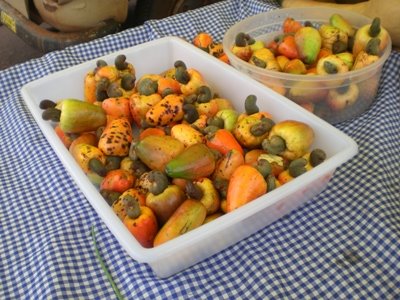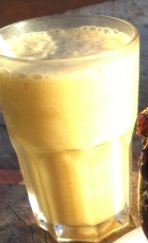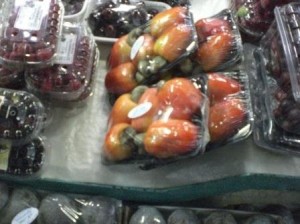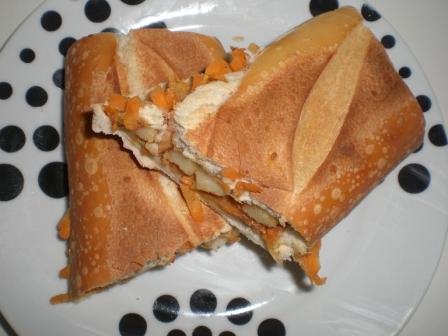
Cashews have always been a favorite in our house. They are the first thing to disappear when a can of mixed nuts happens to show up at a party. Before moving to Brazil, I knew cashews were quite popular due to the fact that they are native to the country. What I didn’t know was that the cashew is popular for a very different reason than the nut we often associate it with. While the nuts can be found; here, cashew is known for its juice.
I was relatively surprised the first time I saw a whole cashew. You see, the picture to the right is of cashews from the farmer’s market in town. Being a plant/tree that is native to the northeast of Brazil the fruit is somewhat rare around here, but for a few weeks in February they do show up at one or two booths among the vendors.
When not speaking of the nut, the cashew is often called a cashew fruit, but in actuality it is made up of three distinct parts. That orange yellow part that I first thought looked like a bell pepper is called the cashew apple. It is referred to as a false fruit or pseudo-fruit in the plant world.
The cashew apple contains a high concentration of tannins which are the same substances found in tea and wine. They give the apple a very distinct taste which I’ll discuss a little later.
The kidney-shaped green stem is the fruit of the cashew and it encases the nut; the same nut that we eat and refer to in the US as simply “cashews”, called castanha de cajú in Brazil.
The green fruit contains urushiol oil, the same substance found in poison ivy and poison oak which irritate the skin. You have to be very careful when removing the nut and it is for this reason that I have never purchased a whole, fresh cashew for myself and experimented with it. In an older article from Purdue University Horticulture I read that in some countries at one point the nut was simply thrown out with the fruit due to this toxin and much more emphasis was placed on the apple.
Cashews are grown in other tropical places throughout the world such as Vietnam and India. However, unless you live very close to one of those places it is likely you will never see a whole cashew. The fruit is juicy, fragile and spoils very quickly so extended transport is not an option.

I have grown to love cashew juice which is made from the cashew apple. It has a sweet flavor with a richness that resembles that of the nut. The tannins leave that familiar drying feel in the mouth which they are known for. This is the reason my husband does not prefer it, but for me it gives the juice a unique appeal.
I have noticed a difference in the juice when I order it in a restaurant versus purchasing it prepackaged in the store. I should mention that you can buy bottled pulp without sugar in the supermarket and add your own water and sweetener if desired. The fresher juice is much more astringent than the packaged.
There are ways to remove tannins and I’m wondering if this has been done to the packaged juice to make it more appealing, as I came across some research from India where they were discussing processes to reduce tannins to get more people to drink the juice for its nutritional content.
Juice from the cashew apple contains about 205 to 220 mg of vitamin C per 100 ml. During my research I found a few sources online in the UK for the cashew apple pulp to make juice.
So even if you may never have the chance to see a whole cashew in person, it is looking like you may still be able to enjoy its flavor and nutrients as the news about cashew juice begins to spread to the rest of the world.







Oh, I learned about the cashew oil the hard way! A boat driver in Kerala gave me the green part with the cashew nut. Silly me, I decided to find the nut inside and the boat driver didn’t say anything! To make a long story short, it took almost 4 weeks for my hands to recover. They peeled, broke out in blisters, peeled again. It was gross and painful. I’d get a knowing smile each time I’d explain my predicament to a Indian pharmacist.
When I told my parents about my experience, my step-father responded, “Everyone knows not to touch cashew oil.” Well, not everyone…
Definitely have never seen a whole cashew before – so intriguing!!
Wow! I just learned so much. I’m not sure I could do the juice. The nut flavor of almond milk freaked me out! Is it anything like that?
I didn’t know about the cashew apple and how the juice is being used. Fascinating. Thanks!
That’s really interesting, I had no idea! I’d like to try cashew juice!
I am SO glad that you wrote this post! I recently had the O.N.E. cashew fruit juice, and I hate to say that I was not particularly fond of it – but it’s so intriguing! I had heard that the nut covering was toxic, so I was pretty confused over how it was all put together. Your post explains everything! Absolutely fascinating!
I learned a lot about cashews in this one! Thanks. I have been curious about cashew juice.
Hmmm…I’ll have to keep an eye out for cashew juice. I’d love to try it!
Oh my gosh, I had completely forgotten about these, one of the many reasons I love your blog! I can’t remember the taste but it was great to read your post!
[Sorry if this is a repeat – I typed up a comment but got an error message when I tried to ‘publish’]
Great post! I never realized that the cashew nuts we eat are just a small part of an entire fruit. My husband mentioned that he had a caipirinha made with cashew juice during one of his trips but I could only picture the nuts being ground up and mixed in somehow. The toxicity of the fruit certainly explains why they are so darned expensive! But after reading Audrey’s experience, I’m totally grateful that we can get it already salted and ready to eat! Excellent information and research.
Fascinating stuff. I knew nothing of cashew fruit, juice or oil, and was only familiar with the bags of cashew nuts that I buy at the Asia Market (though, of course, they had to come from somewhere!). I’m feeling much better informed on the subject now 🙂
so interesting! i knew nothing about any of this! i really want to try all of these different cashew flavored things now – i adore the cashew flavor.
I actually have tried cashew juice once, at a Healthy Show here. It was the O.N.E brand. I don’t know if I’ve seen it in stores though. It was really tasty 😀
Audrey – That is just awful!! I can’t believe the driver didn’t tell you. I could have done the same thing if someone hadn’t told us here. It is for this reason that when I see an exotic new fruit at the market, I don’t automatically buy it. I research it first because some of them can have some scary dangerous stuff.
VeggieGirl – I think they are pretty cool. Fortunate to have the experience.
Erica – Haven’t tried Almond milk yet, but I plan to give it a whirl. I’ll let you know the comparison when I do and you can decide if the cashew juice is safe to try. 😉
5 Star Foodie and Lesley – So glad you liked it!
cathy – I remember you asking me about it so i thought you’d like this post. I haven’t decide if cashew juice is a love/hate thing or an aquired taste. I like it, took some to my mom and she loves it, yet my husband really dislikes it.
Meg – You are welcome!
Mindy – I’d love to hear if they have it out your way. I’m not sure how popular it is in Europe.
ChefBliss – Glad I could bring back some good memories. You’ll have to get your hands on some in the states so you can remember. 🙂
Tangled Noodle – I thought the same thing when I found out the process – it more than explains the pricing. I’ve heard it is popular with the drink, but I haven’t had that flavor yet. The kiwi flavor is good though. 🙂
Daily Spud and Heather – So glad I could share some information. I love being able to help! 🙂
frenchfries – I’m glad to hear that. I definitely need to search that out. I want to see how it compares to what I’ve had here.
I remember being very confused when I had cashew juice for the first time in Brazil. My hosts (family friends) spoke perfect English and told me it was cashew juice, but I just couldn’t believe that it was juice made from a nut and thought I wasn’t understanding them. Once I saw the whole fruit I understood that a cashew was more than just a nut!
Erica, I’ve never had almond milk, but I thought that cashew juice really did have the same flavor as the cashew nut, so it sounds like it may not be your thing.
Emily – It is so weird when you first hear about it. My thoughts were – how do you juice a nut? Ha, ha!
This reminds me of a curry I used to eat when I was a kid and we visited my relatives in Mangalore(everyone there has cashwenut trees along with coconut trees and pepper plants)It’s made with whole tender cashews,coconut and green chillies-must ask my mom for the recipe.Then again,where would I get tender cashews-hmmmmm
I just finished an 8oz carton of O.N.E. cashew juice. As I was purchasing the juice, I commented to a really good looking young man standing near me, about my puzzlement over the item. I’m an old “cocker” (an old guy) and have never understood how to recognize which guys aere good looking. I just always hoped I was one. I know the fellow was “hot” because several of the young female employees were fawning over his two children far mor than made sense. He told me he had spent the last couple of years in Belize supervising the construction of their new aquiriam. We discussed the unique apple, fruit and nut. The cashew is so interesting I have been finding excuses to explain it to total strangers.
Believe it or not, 43 years ago i met a gentleman that worked at the 1910 World’s Fair in St Louis where the fruit was intrduced to America. He stated before the fair the nut was thought to be poisness. The fair was the only time he had eaten the nut. He ate thousands to prove to person after person they were not poisenous. Now I can see where the poison idea came from.
I have pulmonary fibrosis which is accompanied by a pretty nasty cough. I have coughed so many times in the past year that I sometimes scream when it gets to me. As I drank the apple like sweet/barely tart juice, it was acting like a expectorent. I spat volumes of foamy stuff (hope you have had your dinner) which stopped a few minutes after I finished the carton. I have not coughed since. It may have been coinsidence, we’ll see. I hope I am on to something. The carton said, well actually it was written on the carton, that the juice was good for your throat, cough etc. If this stuff helps I will be telling the head of the pulmonary division at the Emory University clinic and research center in Atlanta. I am in trials there.
Maybe Elli Lilly will buy up all the trees and sell the stuff by prescription only, making their usual $billions annually and corber the world cadhew market at the same time.
I am so sorry and embarrassed; the uncorrected copy of my post became my post.
The nut is extracted from the fruit by first drying the fruit (through heating, frying, whatever is easiest). The nut extracted from the fruit is not what you get in America or Europe. What you get there is the dried nut. The fresh nut is soft and has a lot more taste than the dried one. It has a name the local language which can be best pronounced as “bee-bare”.
Thanks so much for the clarification.
I have recently returned from a trip to Senegal and The Gambia. Along the way to The Gambia we noticed a grove of trees with fruit. Our guide stopped our bus and allowed us to explore. He explained to us that they were cahew trees, washed the fruit off and gave it to us to eat. He never explained how toxic it was. I picked a few and placed them in my resort room frig at the Atlantica, but because I unplugged the frig to charge my camera i had to throw the fruit out. A companion was not so fortunate. she tried to bite open the core burned her lip. It was horrible.
Any information on home processing of cashew apple juice of jelly would be appreciated. I am researching all ideas for processing of my cashew apple fruit. Raw fruit just cracked open nuts before roasting ? How are they washed any ideas?
Darlene – So sorry to hear that. I’m really surprised that the guide didn’t share the info about the dangers. After learning about the cashew, I have to say it really changed how I shop for and eat fruits in other countries. I’m always on the look out for the small details.
Anonymous – Sorry, but I don’t have any information on processing the cashew. I have no idea how one would go about doing that at home.
Cashew “feni” is an alcoholic brew made from Cashew apples in Goa- Considering that Goa is a former Portugese colony (and so is Brazil), cashew is part of the culture there. I have personally made cashew wine from Cashew apples- the flavor takes getting used to.
Currently living in Brazil and my family loves cashew (caju) juice. When we lived in the US, we were able to find bottled cashew juice/pulp at most Brazilian stores or stores in Brazilian communities in larger cities. The best brands are Jandaia or Maguary and the name of the fruit on the bottle was Caju which is Portuguese for cashew. I hope this helps those in the US.
As kids in the Caribbean we would collect cashew nuts during the bearing season and then we would roast them to burn off the oil, then we would crack them open to get the nuts.
I found the cashew apple in an international food store in the frozen section. I had never tried the fruit until today and I really like it.
I was introduced to whole cashew fruits in Honduras (along with guabana, cocoa, nance, lychee, and a myriad of other unusual fruits). They called them meriones. I wasn’t warned about the urushiol oils either…my boyfriend, family members and neighbors didn’t seem affected by it, I WAS. After gathering the cashews, everyone holding the fruit while sucking the apple’s juice then snapping off the fruit and roasting them and cracking them open.. My palms started to itch, swell and redden, becoming very painful. My palms were one solid blister I developed hive- like welts on my arms and legs and even the soles of my feet…probably where I occassionally rubbed or touched while handling the fruit. It lasted for weeks! Horrible! I never did discover what caused it…now, I know.
We just moved to Costa Rica two months ago. I just came off the beach (Playa Tamarindo) from my morning walk with my dog. I went searching in the two trees that bear this fruit. There it was in the second tree – a big, beautiful cashew fruit. I picked it, gently carried it to the car. When I got home, I rinsed it, removed the fruit part, cubed it, and juiced it with a lemon squeezer. It is so refreshing and sweet. The tannins were not a strong as a smaller one I had juiced a month ago. If you ever get the chance to try one, do so. They’re yummy!
Hi Celeste! Costa Rica, how exciting! I do need to find the fresh fruit and give it a try. That juice is one of the things I really miss about Brazil. It was so unique!
Hi everyone,
Iam from Kerala, India.
Yes, Cashew is a native plant here, and as of many homes here in my home town we also have one huge Cashew tree. Cashew for me brings a lot of childhood memories, as someone else already said, in my home as well cashew was the quickest to disappear from the kitchen. The actual technique of getting the nut out of the fruit (“the traditional method or atleast the native method”) which was taught to me by my grandmother is actually an intriguing and fun technique. The only way to get the nut out of the fruit without going through the oil was – Fire. The main obstacle on opening the nut is the oil, but putting the fruit into the fire, the oil would simply burn way! And it burns like a boss! its like a rocket in its initial stage of its launch, the heat opens up the hard shell, pouring out the oil which instantly catches fire and put up quite an amazing show. The method is quite simple yet had a tinch of danger 😀 . A heap of dry leaves is first made, then in goes the fruits and then the heap is let to burn away. Easier said than done! The important and hard part is get the nut cooked properly. The actual fun part was opening a badly burnt fruit, praying that the nut isnt over cooked and seeing that it is cooked just right or opening a evenly burnt fruit and getting a completely burnt nut!
One more thing I would like to share, probably a less common one!! One which VeggieGirl would not have known..
Another method of getting the nut:- Planting it!!
It is true, once the it sprouts and grows a few cm long with atleast 2 leaves, it is ready!
The nut now would have pierced through the casing and could be easily plucked and eaten. Now the nut is no longer white, it is Green. And would pack a whole different flavor and texture.
If possible go buy a packet of the whole fruit, twist and pull out the fruit and try out both methods if u have a crave for the nut 😉
PS: While cooking the fruit in fire, keep a safe distance from it the oil catches fire suddenly and violenty….the oil alone is harmful enouh, so once on fire..it would be Satan 😀
Thanks so much for sharing your knowledge and experiences, Jairaj!